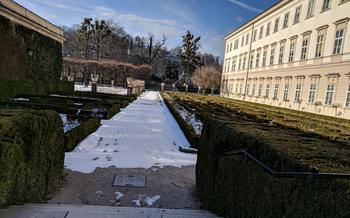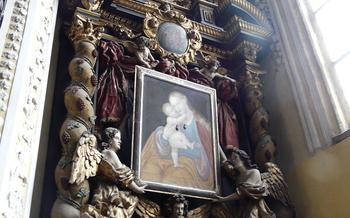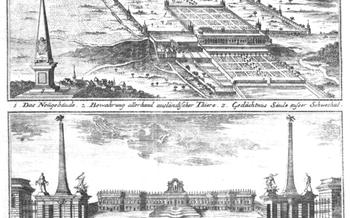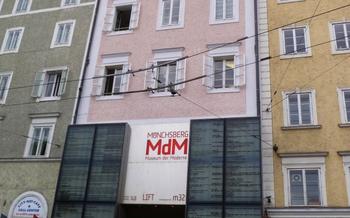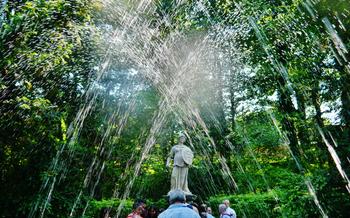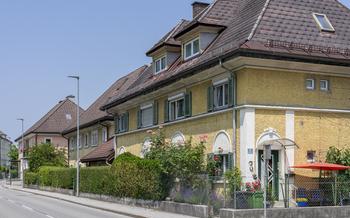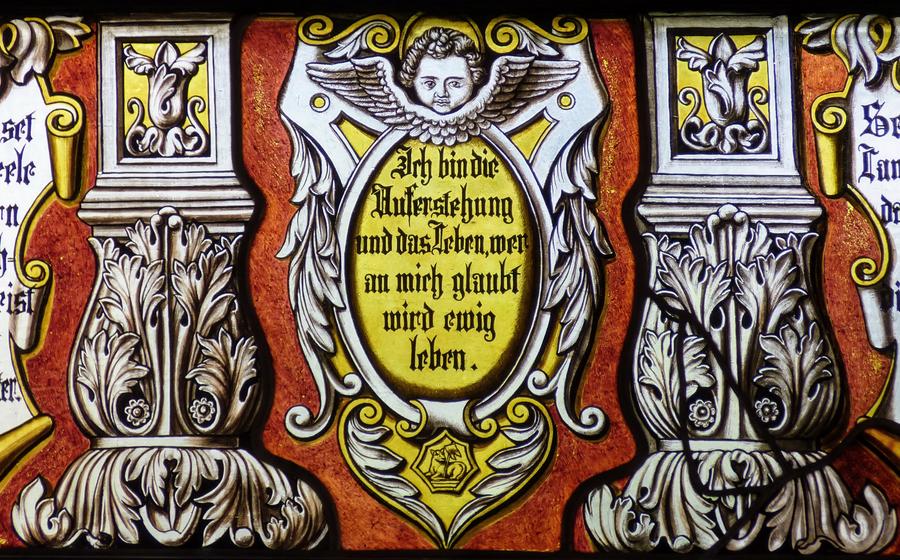
Mirabell Palace and Gardens
- The Mirabell Palace
- The Mirabell Gardens
- The Rose Garden
- The Orangery
- The Zwerglgarten (Dwarf Garden)
- The Marble Hall
- The Grand Staircase
- History and Significance
- Architectural Features and Design
- Legends and Stories
- Practical Information for Visitors
- The Hall of Mirrors
- The Imperial Apartments
- The State Rooms
The Mirabell Palace
In the heart of Salzburg, Austria, lies a Baroque jewel that has captivated visitors for centuries: the Mirabell Palace. With its intricate architecture, lush gardens, and storied past, the palace stands as a testament to the city's rich history and enduring charm.
Built in the 17th century by Prince-Archbishop Wolf Dietrich Raitenau, the Mirabell Palace was a gift of love for his mistress, Salome Alt. Designed by the Italian architect Santino Solari, the palace showcased the opulence and grandeur of the Baroque era. Its elegant facade adorned with intricate carvings, graceful arches, and delicate pastel hues, exudes an aura of timeless beauty.
Over the years, the Mirabell Palace served as a residence for archbishops, a hunting lodge, and even a military hospital. Today, it is a beloved cultural landmark, open to the public and hosting a variety of events and exhibitions. The palace's ornate halls, grand staircases, and opulent state rooms provide a glimpse into the lavish lifestyle of Salzburg's former rulers.
The Mirabell Gardens
The Mirabell Gardens, a sprawling green oasis in the heart of Salzburg, Austria, offer visitors a sanctuary of tranquility and beauty. Designed in the early 17th century by Prince-Archbishop Wolf Dietrich von Raitenau as a gift to his mistress, Salome Alt, the gardens have been meticulously maintained and expanded over the years, showcasing a harmonious blend of Renaissance and Baroque influences.
Highlights of the Mirabell Gardens
Among the many highlights of the Mirabell Gardens are the Rose Garden, a fragrant haven featuring over 12,000 roses of every hue and variety; the Orangery, a stunning glasshouse that houses a collection of exotic citrus trees and tropical plants; and the Pegasus Fountain, a magnificent water feature adorned with intricate sculptures that symbolize the union of the four elements.
Seasonal Changes and Special Events
The Mirabell Gardens undergo a series of seasonal transformations, each offering a unique spectacle. In spring, the gardens burst into bloom with an array of colorful flowers, while in summer, visitors can enjoy the shade of the mature trees and the sound of the cascading fountains. Autumn brings a vibrant tapestry of colors as the leaves turn golden and red, and in winter, the gardens take on a magical, snow-covered charm. Throughout the year, the Mirabell Gardens host a variety of special events, including concerts, art exhibitions, and theatrical performances, making it a vibrant cultural hub for locals and tourists alike.
The Rose Garden
The Rose Garden, a fragrant oasis nestled within the Mirabell Gardens, is a true testament to the beauty and diversity of roses. Spanning over 2,000 square meters, it boasts a collection of more than 10,000 roses, representing over 100 different varieties. Visitors are greeted by an explosion of colors, from delicate pastels to vibrant hues, as they stroll along the meandering paths that wind through the garden.
Among the highlights of the Rose Garden is the Duftrosengarten, a section dedicated to fragrant roses. Here, visitors can immerse themselves in the heady aromas of some of the most exquisitely scented roses in the world, including the Damask rose, the Centifolia rose, and the Alba rose.
Another must-see is the Rosarium, a collection of over 1,000 different types of roses arranged in a series of concentric circles. This stunning display showcases the diversity of roses, from classic varieties to modern hybrids, each with its unique characteristics and charm.
Throughout the year, the Rose Garden undergoes seasonal transformations. In spring, the roses burst into bloom, filling the air with their sweet fragrance. In summer, the garden is a riot of color, with roses of all hues vying for attention. In autumn, the roses take on a more subdued beauty, their petals tinged with shades of gold and bronze.
In addition to its natural beauty, the Rose Garden is also a popular venue for special events. During the summer months, the garden hosts a series of concerts and performances, providing visitors with the opportunity to enjoy the roses while listening to live music or watching a theatrical production.
Whether you are a passionate rose enthusiast or simply someone who appreciates the beauty of flowers, the Rose Garden at Mirabell Palace is a must-visit destination. Take your time to wander through the garden, admire the roses in all their glory, and let their fragrance transport you to a world of tranquility and beauty.
The Orangery
The Orangery, a stunning glasshouse built in the 17th century, is a testament to the Baroque style of architecture and the love of nature during that period. Originally intended for growing citrus trees and exotic plants, the Orangery stands as a testament to the horticultural advancements of the time.
Its spacious interior, flooded with natural light, creates a warm and inviting atmosphere. Adorned with intricate carvings and delicate moldings, the Orangery showcases the craftsmanship and artistry of its era. The rows of tall, arched windows offer panoramic views of the surrounding gardens, blurring the boundaries between the indoors and outdoors.
Today, the Orangery serves as a versatile venue for exhibitions, concerts, and other cultural events. Its unique ambiance and historical charm provide a captivating backdrop for various gatherings. Whether hosting a corporate function, a wedding celebration, or an art exhibition, the Orangery offers an unforgettable experience for all who enter.
The Zwerglgarten (Dwarf Garden)
The Zwerglgarten, or Dwarf Garden, is a unique and captivating feature of the Mirabell Gardens. Created in the 17th century, this enchanting garden is home to a collection of 28 dwarf statues, each with its own distinct personality and charm.
The Dwarf Garden was designed by the renowned sculptor Kaspar Gras, who was commissioned by Archbishop Wolf Dietrich von Raitenau to create a series of statues that would add a touch of whimsy and amusement to the gardens. The statues are made of Untersberg marble and depict a variety of characters, including jesters, musicians, and even a group of dwarfs playing cards.
Visitors to the Dwarf Garden are often captivated by the intricate details and expressions of the statues. Each dwarf has its own unique story to tell, and visitors can spend hours exploring the garden and discovering the hidden treasures within.
Among the most popular statues in the Dwarf Garden is the "Wasserspeier," or Water Spouter. This mischievous dwarf is depicted holding a fish and squirting water from its mouth, much to the delight of visitors.
Another highlight of the Dwarf Garden is the "Zwergenbrunnen," or Dwarf Fountain. This charming fountain features a group of dwarfs frolicking and playing in the water, creating a sense of joy and movement.
The Dwarf Garden is a beloved spot for both locals and tourists alike. It is a place where visitors can escape the hustle and bustle of everyday life and immerse themselves in a world of magic and enchantment.
The Marble Hall
The Marble Hall, also known as the Marble Gallery, is a stunning and majestic space within the Mirabell Palace. Constructed in the 17th century, this opulent hall was designed by the renowned architect Johann Bernhard Fischer von Erlach. It derives its name from the exquisite marble that adorns its walls, columns, and flooring, creating an aura of grandeur and elegance.
The Marble Hall's architectural design is a testament to the Baroque style that was prevalent during its construction. The hall features a vaulted ceiling adorned with intricate frescoes depicting mythological scenes and allegorical figures. The walls are lined with pilasters and topped with a balustrade, adding to the room's sense of height and grandeur.
Today, the Marble Hall is primarily used for official functions and special events due to its grandeur and historic significance. It provides a breathtaking backdrop for weddings, receptions, concerts, and other prestigious gatherings. Visitors can admire the hall's opulent décor, including crystal chandeliers, ornate mirrors, and fine works of art that add to its regal atmosphere.
Practical Information:
- Opening Hours: The Marble Hall is generally open to the public during regular palace hours, which may vary depending on the season. Check the official website for specific opening times.
- Admission Fees: Admission to the Marble Hall is typically included in the general admission ticket for the Mirabell Palace. Guided tours of the palace often include a visit to the Marble Hall, providing visitors with insights into its history and significance.
- Accessibility: The Marble Hall is accessible to visitors with disabilities via wheelchair ramps and elevators. Visitors with special needs are advised to contact the palace administration in advance to make arrangements for assistance.
The Grand Staircase
The Grand Staircase, also known as the "Ehrensaal," is a magnificent architectural masterpiece located within the Mirabell Palace. Constructed during the palace's renovation in the late 17th century, this opulent staircase serves as a grand entrance to the palace's State Rooms.
History and Significance
The Grand Staircase holds significant historical importance, having witnessed countless royal processions, celebrations, and diplomatic gatherings throughout the years. Its grandeur and intricate design reflect the opulence and extravagance of the Salzburg archbishops who resided in the palace.
Architectural Features and Design
The Grand Staircase is a testament to the Baroque architectural style that dominates the Mirabell Palace. Its sweeping double staircase, adorned with intricate wrought-iron railings, creates a dramatic and awe-inspiring visual effect. The walls are embellished with elaborate stucco work, featuring garlands, cherubs, and allegorical figures that add to the staircase's grandeur.
Legends and Stories
The Grand Staircase is steeped in legends and stories that have been passed down through generations. One tale speaks of a mysterious ghost that haunts the staircase, said to be the spirit of a former archbishop who met his untimely demise within the palace walls.
Practical Information for Visitors
-
Location: The Grand Staircase is situated on the ground floor of the Mirabell Palace, accessible from the main entrance.
-
Photo Opportunities: The staircase offers stunning photo opportunities, capturing its architectural details and the grandeur of the palace's interior.
The Hall of Mirrors
The Hall of Mirrors, located on the first floor of the Mirabell Palace, is one of its most opulent and awe-inspiring rooms. It was built in the 17th century as a grand reception hall for Prince-Archbishop Johann Ernst von Thun. The hall is renowned for its stunning mirrored walls, which create an illusion of infinite space and grandeur.
The mirrors were imported from Venice and are arranged in intricate patterns, reflecting the light from the crystal chandeliers and creating a magical ambiance. The ceiling of the hall is adorned with beautiful frescoes depicting scenes from Greek mythology, adding to its grandeur.
The Hall of Mirrors has witnessed countless historical events, including lavish banquets, balls, and ceremonies. It was here that Wolfgang Amadeus Mozart, a young prodigy at the time, performed for the prince-archbishop and his court. Today, the hall is used for various events, including concerts, exhibitions, and weddings.
Visitors to the Mirabell Palace can marvel at the splendor of the Hall of Mirrors and imagine themselves transported back in time to the lavish court of the prince-archbishops. The hall is a testament to the artistic and architectural achievements of the Baroque era and is not to be missed when visiting the palace.
The Imperial Apartments
The Imperial Apartments, located within the Mirabell Palace, offer a glimpse into the opulent lifestyle of the ruling Habsburg family. These private chambers were once home to the prince-archbishops of Salzburg and their families, and they have been meticulously preserved to reflect their grandeur.
The Imperial Apartments consist of a series of lavishly decorated rooms, each with its unique character. Visitors can wander through the grand bedrooms, with their intricate tapestries and ornate furniture, and imagine the sumptuous banquets that were held in the opulent dining room. The highlight of the apartments is the exquisite Hall of Mirrors, which boasts a stunning collection of mirrors and chandeliers that reflect the light in a mesmerizing display.
Today, the Imperial Apartments are open to the public as a museum, showcasing the opulent lifestyle of the Habsburg dynasty. Guided tours are available, providing visitors with insights into the history and significance of these magnificent rooms.
The State Rooms
The State Rooms of the Mirabell Palace are a testament to the opulence and grandeur of the Austrian monarchy. These rooms were used to host lavish receptions, state banquets, and other official events. The most impressive of the State Rooms is the Throne Room, which features a massive throne adorned with intricate carvings. The Banquet Hall is another highlight, with its long tables and opulent chandeliers.
The State Rooms are open to the public for guided tours, which offer a glimpse into the lives of the Habsburg emperors and empresses. Visitors can admire the exquisite furnishings, tapestries, and paintings that adorn these rooms. The tours also provide insights into the history and significance of the Mirabell Palace, making them a must-do for anyone interested in Austrian history and culture.
Practical Information:
- Opening Hours: The State Rooms are open for guided tours from Tuesday to Sunday from 9 am to 5 pm.
- Admission Fees: Admission to the State Rooms is included in the Mirabell Palace ticket, which costs €12 for adults and €6 for children and students.
- Guided Tours: Guided tours of the State Rooms are available in English and German. Tours must be booked in advance and cost an additional €3 per person.
